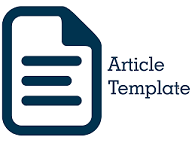Development of a Canva-Based Educational Website as an Innovation in Digital Learning Media
Abstract
This research aims to develop an educational website based on Canva as an innovation in digital learning media that supports teachers, particularly Islamic Religious Education (PAI) teachers in both formal and non-formal educational units, in presenting teaching materials more practically, integratively, and easily accessible. The background of this research stems from the challenges of 21st-century education, which demand interactive, efficient learning processes that align with the Sustainable Development Goals agenda (SDG 4: Quality Education). The research method used is Research and Development (R&D) with the Waterfall model, which includes the stages of needs analysis, design, implementation, testing, and maintenance. The developed product contains various learning media, teaching modules, and a list of relevant Artificial Intelligence (AI) applications to support learning. The results of the Black Box Testing method show that all website features function as designed, are responsive, and can be accessed on various devices. This Canva-based educational website is considered suitable for use as a digital learning medium because it can improve teacher efficiency, enrich students' learning experiences, and contribute to the realization of inclusive, innovative, and sustainable education.
Full Text:
PDFReferences
Aini, W. (2019). Difficulties of Equality Education in the Sumatera Area. KOLOKIUM Jurnal Pendidikan Luar Sekolah, 7(1), 9-19.
Alisjahbana, A. S., & Murniningtyas, E. (2018). Tujuan pembangunan berkelanjutan di Indonesia: konsep, target, dan strategi implementasi. Unpad Press.
Ardiansyah, D., & Purnamasari, A. I. (2024). Perancangan Website Pembelajaran Bahasa Jepang dengan Fokus Materi Klausa melalui Metode Waterfall. Jurnal Informatika Terpadu, 10(1), 49-57.
Asrulla, R., Jailani, M. S., & Jeka, F. (2023). Populasi dan sampling (kuantitatif), serta pemilihan informan kunci (kualitatif) dalam pendekatan praktis. Jurnal Pendidikan Tambusai, 7(3), 26320-26332.
Bakti, I., & Firdaus, M. (2024). Waterfall Metodancangan Software Untuk Pemula. Jakarta: CV. Media Sains Indonesia.
Bappenas, (2022). Laporan Pelaksanaan Pencapaian TPB/SDGS Tahun 2021. Jakarta: Bappenas.
Eriana, E. S., & Zein, D. A. (2023). Artificial Intelligence. Angewandte Chemie International Edition, 6(11), 1.
Ferguson, T., & Roofe, C. G. (2020). SDG 4 in higher education: Challenges and opportunities. International Journal of Sustainability in Higher Education, 21(5), 959-975.
Friska, J., & Pramuaniati, I. (2023). Effectiveness of using Canva Application to Improve Learning Outcomes of Tenth Grades Students. Jurnal Penelitian Dan Pengembangan Pendidikan, 7(3), 421-427.
Irwanto, I. (2021). Perancangan Sistem Informasi Sekolah Kejuruan dengan Menggunakan Metode Waterfall (Studi Kasus SMK PGRI 1 Kota Serang-Banten). Lectura: Jurnal Pendidikan, 12(1), 86-107.
Khayati, N. A., Muna, F., Oktaviani, E. D., & Hidayatullah, A. F. (2020). Teacher's Role Program in Inclusive Education to Achieve Sustainable Development Goals (SDGs). KOLOKIUM Jurnal Pendidikan Luar Sekolah, 8(1), 1-6.
Kioupi, V., & Voulvoulis, N. (2020). Sustainable development goals (SDGs): Assessing the contribution of higher education programmes. Sustainability, 12(17), 6701.
Kopnina, H. (2020). Education for the future? Critical evaluation of education for sustainable development goals. The Journal of Environmental Education, 51(4), 280-291.
Mariyati, D., Wahjoedi, W., & Suciptaningsih, O. A. (2024). Development of E-Modules for Problem-Based Science Materials in Class IV of SDN Bunulrejo 04 Malang. KOLOKIUM Jurnal Pendidikan Luar Sekolah, 12(2), 347-362.
Nazar, R., Chaudhry, I. S., Ali, S., & Faheem, M. (2018). Role of quality education for sustainable development goals (SDGS). International Journal of Social Sciences, 4(2), 486-501.
Rahmawati, L., Ambulani, N., Desty Febrian, W., Widyatiningtyas, R., & Sukma Rita, R. (2024). Pemanfaatan Aplikasi Canva Dalam Penyusunan Media Pembelajaran Berbasis Teknologi. Communnity Development Journal, 5(1), 129–136.
Ronzhina, N., Kondyurina, I., Voronina, A., Igishev, K., & Loginova, N. (2021). Digitalization of Modern Education: Problems and Solutions. International Journal of Emerging Technologies in Learning (iJET), 16(04), pp. 122–135. https://doi.org/10.3991/ijet.v16i04.18203
Samsu, S. (2021). Metode Penelitian:(Teori Dan Aplikasi Penelitian Kualitatif, Kuantitatif, Mixed Methods, Serta Research & Development).
Saputra, A. G., Rahmawati, T., Andrew, B., & Amri, Y. (2022). Using Canva application for elementary school learning media. Scientechno: Journal of Science and Technology, 1(1), 46-57.
Solfema, S., Wahid, S., & Pamungkas, A. H. (2018). Alat Permainan Edukatif (APE) Berbasis Bahan Lingkungan dalam Mengatasi Permasalahan Pembelajaran Pendidikan Anak Usia Dini. KOLOKIUM Jurnal Pendidikan Luar Sekolah, 6(2), 107-111.
Titiyanti, Y., Anam, S. U., & Retnaningdyah, P. (2022). Implementing Canva in the digital learning process for junior high school. Jurnal Education and Development, 10(3), 708-712.
Wang, C., Zhang, M., Sesunan, A., & Yolanda, L. (2023). Peran teknologi dalam transformasi pendidikan di Indonesia. Kemdikbud, 4(2), 1-7.
Wardana, M. A. W., Sumarwati, S., & Setiawan, B. (2022). Implications of The Minimum Competency Assessment (AKM) on The Literature Motivation Of Students Of SMP PGRI 2 Wates, Blitar Regency. KOLOKIUM Jurnal Pendidikan Luar Sekolah, 10(2), 92-111.
Wicaksono, S. R. (2021). Black Box Testing Teori Dan Studi Kasus. Malang: CV. Seribu Bintang, 37-48.
Yuliana, D., Baijuri, A., Suparto, A. A., Seituni, S., & Syukria, S. (2023). Pemanfaatan aplikasi Canva sebagai media video pembelajaran kreatif, inovatif, dan kolaboratif. Jurnal Pendidikan Teknologi Informasi (JUKANTI), 6(2), 247-257.
DOI: https://doi.org/10.24036/kolokium.v13i2.1153
Refbacks
- There are currently no refbacks.

This work is licensed under a Creative Commons Attribution 4.0 International License.

